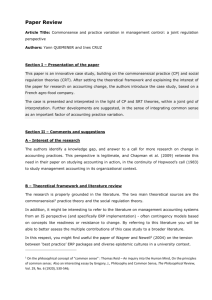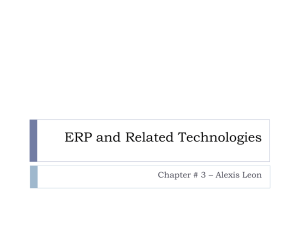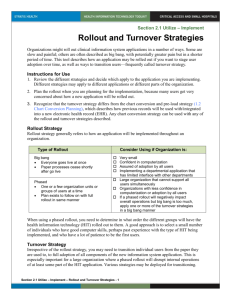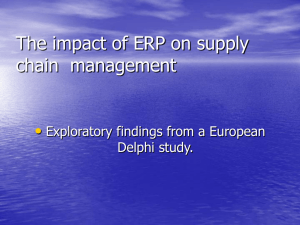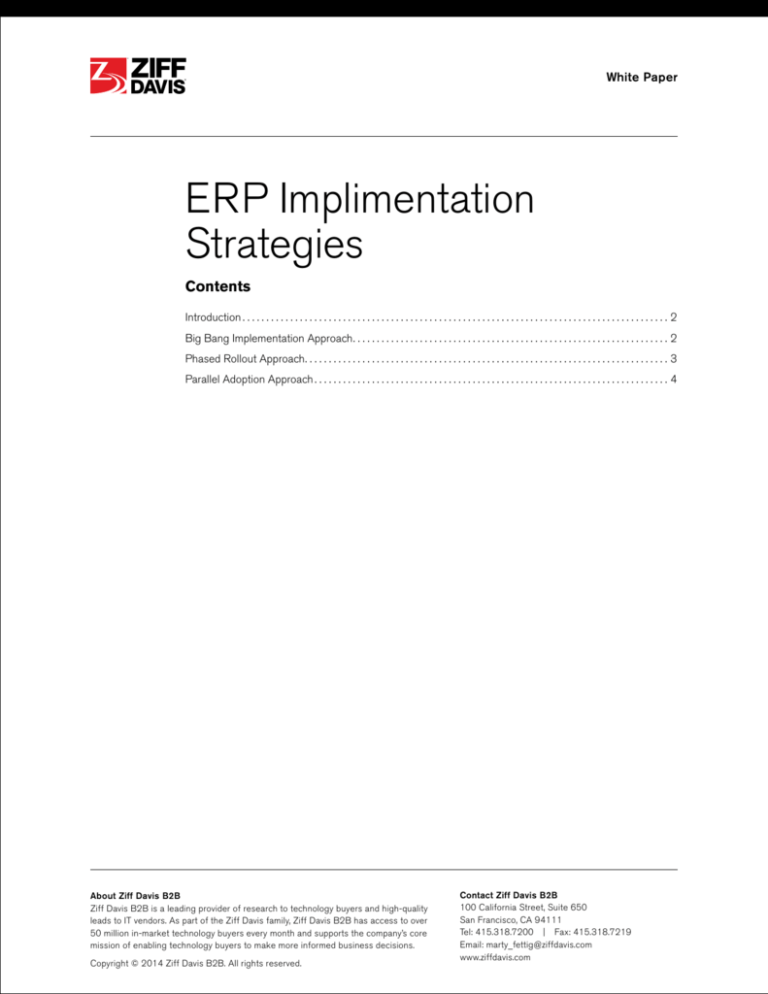
®
White Paper
®
ERP Implimentation
Strategies
Contents
Introduction. . . . . . . . . . . . . . . . . . . . . . . . . . . . . . . . . . . . . . . . . . . . . . . . . . . . . . . . . . . . . . . . . . . . . . . . . . . . . . . . . . . . . . . . . . 2
Big Bang Implementation Approach. . . . . . . . . . . . . . . . . . . . . . . . . . . . . . . . . . . . . . . . . . . . . . . . . . . . . . . . . . . . . . . . . . . 2
Phased Rollout Approach. . . . . . . . . . . . . . . . . . . . . . . . . . . . . . . . . . . . . . . . . . . . . . . . . . . . . . . . . . . . . . . . . . . . . . . . . . . . . 3
Parallel Adoption Approach. . . . . . . . . . . . . . . . . . . . . . . . . . . . . . . . . . . . . . . . . . . . . . . . . . . . . . . . . . . . . . . . . . . . . . . . . . . 4
About Ziff Davis B2B
Ziff Davis B2B is a leading provider of research to technology buyers and high-quality
leads to IT vendors. As part of the Ziff Davis family, Ziff Davis B2B has access to over
50 million in-market technology buyers every month and supports the company’s core
mission of enabling technology buyers to make more informed business decisions.
Copyright © 2014 Ziff Davis B2B. All rights reserved.
Contact Ziff Davis B2B
100 California Street, Suite 650
San Francisco, CA 94111
Tel: 415.318.7200 | Fax: 415.318.7219
Email: marty_fettig@ziffdavis.com
www.ziffdavis.com
Ziff Davis | White Paper | ERP Implementation Strategies
Introduction
There are many approaches an organization can take when it comes to ERP implementation
but the most important thing to remember is to choose the best strategy for your particular
business. As such, there are basically three commonly used methodologies for you to
consider.
•
Big bang rollout - Here, the implementation happens in one single go. All users move to
the new system on a given date.
•
Phased rollout - Here, the implementation occurs in phases over an extended period of
time. Users move onto new system in a series of steps over a period of time.
•
Parallel adoption - Here, both the legacy and new ERP system run in parallel. Users learn
the new system while working on the old.
Big Bang Implementation Approach
A big bang ERP implementation happens in a single major event. The installation ofERP
systems and all the modules happens across the entire organization at once, hopefully after a
great amount of proper planning. Of course, there are many pre-implementation activities that
need to be carefully planned and carried out in preparation for this big bang event but once
these activities are carried out then the old system will be turned off so the new system can
take over. This implementation methodology was commonly used in the earlier days of ERP
-- and also contributed to the higher rate of failure – but it is also quick and often less costly in
the long run. Here is a quick look at the advantages and disadvantages.
Advantages:
•
Shorter implementation cycle
•
Cost effective in the long run
•
From an employee perspective this is much easier to use as they don’t need to use two
different systems for different needs
•
Implementation date is fixed and everybody is mentally prepared
Disadvantages:
ziffdavis.com
•
Needs very meticulous planning in terms of fall back options
•
More difficult to manage and there may be multiple dependencies
•
Employees may have less time to familiarize themselves with the new system
2 of 4
Ziff Davis | White Paper | ERP Implementation Strategies
•
Planning has to be absolutely flawless as the risks associated with this approach are very
high
•
Any failures on one system can have a cascading effect on others
•
There could be an “Initial Dip Phenomenon” which happens shortly after any
implementation because users are struggling with the new system and organizational
performance suffers
Phased Rollout Approach
This is different from the Big Bang because the changes do not happen all at once but rather
in a series of pre-determined steps and over a period of time. For example, a phased rollout
might be approached by module, business unit, or location:
Phased Rollout by Module - This is the most commonly approach. The modules are
implemented one by one. The critical ones are implemented first and then the rest get added
over time. In this approach the recommendation is to begin with core business functions –
those necessary for daily operations -- and then slowly add in more modules and functionality
with each phase. The reasoning behind this is that you are going to gather a great amount of
learning and the necessary experience since the nuances of the system are exposed to you
much earlier which makes you better prepared for the implementation in each subsequent
phase of the project.
Phased Rollout by Business Unit - This approach is usually done by larger organizations. Here,
implementation is carried out in one or more business units or departments at a time. For
example, you begin with implementation in Material Management and then move to Inventory,
Accounting, Payroll etc. As the team gains more experience with each implementation, the
subsequent phases become more efficient.
Phased Rollout by Geography - For organizations with multiple locations, a phased rollout
by geography is a common approach. For example, you begin with implementation in APAC,
and then slowly you move to EMEA, Americas and other geographic locations. Each of
the geographies will have their own business process defined and the challenge here is to
agree on a common business process at least 80% and the other 20% could be customized
depending upon the specific needs of the geography. This approach is also called pilot
approach. Again, there are advantages and disadvantages for phased implementations.
Advantages:
ziffdavis.com
•
Very helpful if the team is new and less experienced in the given technology
•
Provides enough time to consolidate all the learning and thus allow subsequent phases
can go smoother
•
It may not need such meticulous planning in terms of fall back options
3 of 4
Ziff Davis | White Paper | ERP Implementation Strategies
•
Less difficult to manage as the focus is limited
•
Employees have enough time to familiarize themselves with the new system
•
In case of any failure on one system, it may not have an adverse cascading effect on
others
•
With conversion occurring in parts, time is available for adjustments
Parallel Adoption Approach
This is one of the least risky ERP implementation methodologies as it includes running of the
old and the new ERP system together. This has also been referred to as “parallel conversion,”
“parallel running,” or “parallel cutover.” As both of the systems work in parallel, users can learn
the new system while performing regular work activities on the old system. Once the new
system meets all the requirements, the old system is discontinued. Here are the advantages
and disadvantages.
Advantages:
•
It is the least risky implementation
•
Pace of change is much slower than big bang but faster than phased approach
•
In case of any unforeseen failure with the new system, the old system still continues
•
It allows overlap and fall-back controls
•
Does not need very meticulous planning in terms of fall back options
Disadvantages:
•
In terms of pure financial terms, this is the most expensive solution
•
Employee has to enter data into both the system.
•
Employee may continue to use the old system thus making the new system least effective
•
Users tend to compare the old and new and take an unnecessarily negative stance
against the unfamiliar
•
Users have psychological issues letting go off the old system
There is no one single ERP methodology that covers all the disciplines required for an ERP
implementation. There is no one-size-fits-all when it comes to implementing an ERP system.
The trick is to learn how to integrate these different methodologies together. Every company
has unique goals, and an implementation requires careful planning and analysis.
ziffdavis.com
4 of 4





